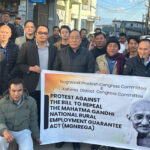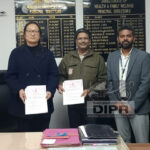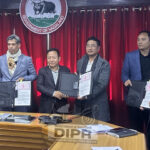Formation of the Forum for Naga Reconciliation (FNR)
The Forum for Naga Reconciliation (FNR) was formed by 39 Naga organizations, inclusive of the Church, in Kohima on 25 March 2008 to work for reconciling the Naga political groups. Since its inception FNR has traversed almost all of Naga-Land—from Niuland to Mon, Noklak to Ukhrul, Zunheboto to Phek, Kohima to Meluri, Senapati to Arunachal, Dimapur to the Naga areas in Burma. Just about everyone we met was suspicious of FNR as being tools of assorted individuals and parties, from veteran Naga politicians to Naga political groups to the Government of India.
In 2008, after a month of intermittent travels, three out of the four Naga political groups at that time—the NSCN (IM), NSCN (K), and the Federal Government of Nagaland/Naga National Council (FGN/NNC under retired Brigadier S Singnya and Zhopra Vero,
kedallo)—consented to a meeting. But according to one group, “not in Nagaland…due to security reasons.” This was justifiable as the situation then was not safe. “Factional” armed encounters were common. Evenings in Dimapur, Kohima, Mokokchung, and other Naga towns had a deserted look with shuttered shops and empty streets. The culture of warm and friendly colonies with children playing and men and women exchanging salem was not the norm then. Fear had overtaken many communities. It reminded me of how I grew up in the 1950s in Kohima with the same dread, remembering the nights my parents and siblings spent in trenches dug inside our home.
FNR was conscious of the implication of taking Naga political groups for reconciliation meetings outside of India, imagining Naga people’s perceptions of “why can’t Nagas meet and talk in Nagaland?” We realized that in order to better understand and address these perceptions, it was important to establish boundaries of trust and acceptance. We learned this through difficult experiences, by sensing others’ fear, suspicion, and anger, and then reflecting these emotions in ourselves to understand them better. This approach has brought us closer to people, but it has also meant there are those who might not agree with us. As a forum, we have to constantly remind ourselves of the need to understand why others think the way they do. This is essential for deeper empathy and connection.
Covenant of Reconciliation (CoR)
A highly respected retired General of one of the Naga political groups knelt in front of a much younger man and asked for forgiveness for the violence done to the Naga people. This happened during a devotional foot-washing service in Chiang Mai, Thailand, on Sunday, 31 May 2009. This small act was a divine touch that left a small, but permanent, mark on the history of Naga healing and forgiveness. In 2009, the factional battles were frequent with lives lost almost daily. For the Naga political groups, any conciliatory signs in words or action were signs of weakness. The General’s action of kneeling and asking for forgiveness may have been seen as a sign of weakness.
After all, our Naga culture has taught us to exhibit a warrior instinct whenever we face the forces of the “enemy.” However, that Sunday morning, I was absolutely certain this act was divinely initiated through Christ to debunk the falsehood of the power of violence, rhetoric, and pride.
After nine meetings, five times outside of India numbering 28 days, and twelve times at home, the late Isak Chishi Swu, late SS Khaplang, and retired Brigadier S Singnya signed the Covenant of Reconciliation (CoR) on 13 June 2009.
For the record, from May 2008 to June 2015, and September 2022 to the present, a total of 286 official meetings were held between the Naga political groups and FNR. To the FNR members, especially those of us who experienced the decades beginning from the late 1980s, the signing of the CoR signaled a new path that led us away from the painful memories of the tears, hatred, and violence of past years. The signing of the CoR contributed to gradually ending factional violence and has shown us a way forward.
Personally, this journey has transformed me in profound ways. I have seen others and myself go from intolerance to acceptance, hate to love, anger to self-reflection, and judgment to forgiveness. Today, without much thinking, the Naga political groups and the public are enjoying the fruits of the CoR, although, I am aware of the pitfalls of the multiplication of groups and taxation. Also, to be sure, the CoR carries no magical surprises. Rather, we confess our finitude.
The Silent Years
The CoR was envisioned to be a catalyst for progress, with an emphasis on inclusive achievement. Accordingly, after many more painstaking years of trust building and creating an environment of relative peace, with the signing of the “Naga Concordant” on 26 August 2011, FNR was “authorized” by the signatories of the CoR to work on a concept note for “One Naga National Government.” This by implication also includes “one tax.” At the height of the discussion, the Government of India invited the NSCN (IM) to Delhi for an “official talk” that eventually led to the signing of the Framework Agreement (FA) on 3 August 2015. This development gave rise to suspicion from the other two signatories of the CoR that FNR had a role in the FA.
On 30 November 2015, the GPRN/NSCN informed me that they “are going their way through other’s help.” They were gracious enough to “thank the FNR for the reconciliation work from May 2008 till this time.” Before the two emissaries parted, I said, “Allow me to pray for you and your new initiative.” After prayer, the two left. That led to what I term as the “Silent Years”—the years from November 2015 to August 2022—between the GPRN/NSCN and the FGN/NNC.
Leaders of NSCN (IM) as well as the Naga National Political Groups (NNPG) know very well as to how the NNPG came into being. FNR does not deserve the credit for what we have not initiated or achieved. During the “Silent Years,” FNR had no official communication with NSCN (IM) or the NNPG as various actors and officials limited communications between these groups and the FNR. For the NNPG, their medium was a few selected people from civil society organizations. Therefore, the notion that FNR gave rise to NNPG is factually not correct and should be ratified.
To me, the “Silent Years” came to an end when, in August 2022, the FNR was asked to arrange a meeting between the NSCN (IM) and the NNPG. Subsequently, the NSCN (IM) and the NNPG met on 14 September 2022, at Sovima, Chumoukedima, leading to the signing of the “Joint September Accordant” that resolved to “strengthen the Covenant of Reconciliation” of 13 June 2009, and “…commit to transcending group differences through cooperation.” Since then, we continue to travel the “Journey of Common Hope,” navigating through challenging and humbling experiences.
Increase of “Groups”
Looking back when FNR activities were taking root, there were mainly four groups—the NSCN (IM), NSCN (K), FGN/NNC (Singnya/Zhopra), and NNC (Adino)—that comprised the Naga political institution. From the end of 2008 and into 2009, there were two other groups lobbying to be “included” in the reconciliation process with the rest of the Naga political groups. With calculated diplomacy, we expressed the wish of those two groups to be included in the process. The immediate answer we received was, “let us not recognize anyone who claims to be a group.” One even said outright, “If they are included, my group will pull out the reconciliation process.” Under concerning circumstances, our work of “creative-tension” with the “excluded” ones went on. Since its inception there have been processes within the process and FNR has had to engage in backdoor diplomacy.
During the “Silent Years,” the NNPG was formed when RN Ravi was the interlocutor of the Naga talks and the Agreed Position was signed on 17 November 2017. This meant that some of the groups that were not involved in the early period of the reconciliation process became part of the newly named NNPG comprising of seven Naga political groups. Later, differences between these groups led to parting of ways, giving rise to newer groups, especially in the recent past.
Contextually, “factionalism,” though unhealthy and counterproductive for the Nagas, remains a reality. This reality will not be erased by anger and criticism; that will only invite opposite reaction. This very costly opposite reaction must not be allowed to happen again in Naga-land.
In the situation Nagas are in, we must learn to accept the reality of “factionalism” in order to move ahead. To categorize groups as “true” and “false”, “genuine” and “duplicate” will only further widen the divide. This is a difficult choice that FNR is faced with. We need to come together to understand the fragmentation of the Naga political institution and the reasons behind them so that the Naga public and the citizens of Naga-land can shoulder the responsibility to turn things around through people’s empathy, passion and resolves, guided by clarity of thought.
A Personal Note
Many of us are only pointing to an already existing problem in different ways: comments, criticism, subjective perceptions, etc. Can we not rise to the challenge of changing the world we have created? Adopting a cynical attitude that our world is unchangeable merely endorses the status quo, perpetuating the current state of despair. Such apathy is harmful for our own people. We must not allow our feeling of hopelessness to be turned inward against ourselves. In walking with the members of FNR and the Naga political groups, I have seen and experienced my limitations. Inadvertently, I have committed many mistakes and I require your forgiveness. If FNR has done something good for the Naga people, the credit goes to the people. By the same token, I would also request the public for your empathy with regards to the difficult equations and centrifugal movements from the centre of power that we face on a daily basis.
I conclude with a thought: In indigenous political culture, land and people are inseparable. It is, therefore, coherent to say that we are living in our nation without a “nation.” In A Theory of Justice (1971), the philosopher John Rawls calls on people to imagine an “original position” on which a homogenous people, such as the Nagas, can decide their basic rights by constructing their fitting forms from below (people’s power) without obliterating their historical and political rights. Can the Nagas begin such a constructive nationalism? I pray we can put our minds to this and transform our fractured world into one of cooperation and hope.
Without any further delay, will the Naga public move ahead?
Wati Aier
(On the occasion of the 15 Anniversary of the CoR, 13 June 2024)



